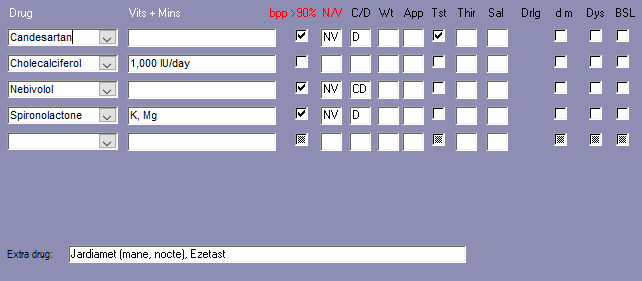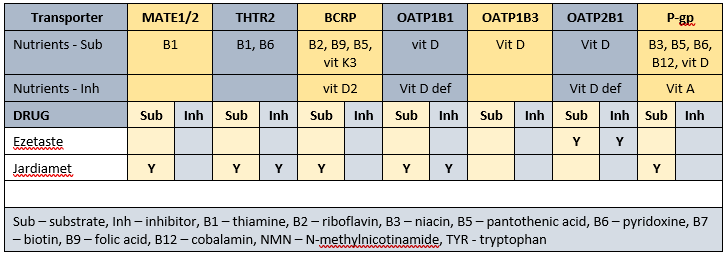Drug-induced tipping points and health management strategies are an unlikely combination and rarely considered. A common definition (https://global-tipping-points.org/what-is-a-tipping-point/) for a tipping point is -
- where a small change makes a big difference to a system (Gladwell [debut novel], 2000), or
- the point at which a series of small changes or incidents becomes significant enough to cause a larger, more important change (Oxford English Dictionary).
This guest case study seems to be an excellent example of a tipping point scenario.
Medications That May Adversely Affect Nutritional Status

Transporter-mediated interactions and nutrients


Side effects summary
Currently prescribed -
- 5 medications that include nausea, vomiting and diarrhoea;
- 3 medications that include altered appetite, and decreased zinc;
- 2 medications that include hypoglycaemia (Ezestat, Jardiamet), hyponatraemia (spironolactone), hyperkalaemia, constipation, altered weight status, and decreased appetite, riboflavin (vitamin B2) and magnesium;
- 1 medication that includes hyperglycaemia (Ezestat), anaemia, hyperuricaemia, hypertriglyceridaemia, hypercholesterolaemia, and decreased thiamine, pyridoxine, cobalamin and folate levels.
Pharmaconutrition data
Both candesartan and spironolactone are associated with decreased zinc status.
Ezestat (statin component ) associated with increased risk of diabetes.
Coffee inhibits vitamin D uptake by osteoblasts (bone builders) by inhibiting their vitamin D receptors. As a consequence of inhibited vitamin D receptors calcium and zinc absorption is also impaired.
Jardiamet (metformin component) negatively impacts availability and status of thiamine, pyridoxine, niacin, folate, B12, vitamin D, and magnesium levels.
Some of the identified membrane transporters alter the absorption and/or organ and cellular uptake of a range of nutrients. Inhibition of membrane transporters means blood test results may be unreliable. To clarify nutrient status advisable to conduct blood tests at least one hour before administration of relevant prescribed medicines. A concurrent detailed Diet History is also essential to corroborate adequacy of intake of all affected nutrients. Further, all affected nutrients to be monitored on a regular basis ie at least annually. Unreliable blood test results due to inhibition of transporters by prescribed medications, is raising concern in some clinical publications.
Nutrients that are affected by Mr ACY’s prescribed medications include -
- substrates - thiamine, riboflavin, niacin, pantothenate, pyridoxine, biotin, folate, B12, vitamin C, vitamin D, vitamin K3, carnitine and choline;
- inhibitors - choline, vitamin A, vitamin D, vitamin D deficiency.
The duration of drug inhibition of transporters currently remains unknown.
Assessment
Mr ACY’s regular 6-monthly checkup in January 2024 identified a number of aberrations that necessitated changes to his prescribed medications. All previous 6-monthly checkups were presumably uneventful, and seemingly there have been no recent significant negative impacts on his health. Further, Mr ACY has been a hardworking and fit man for most of his adult life. Given the current scenario, it is reasonable to question why there were such significant aberrations at this routine checkup.
Tipping point
Mr ACY’s health conditions had remained stable for quite some time, and consequently so had his prescribed medications. The sustained inhibition of a range of membrane transporters likely resulted in a sustained and chronic malnutrition of key nutrients. The increasing chronic malnutrition probably triggered the tipping point with resultant aberrant responses that may be irreversible.
The concept of a tipping point has been enthusiastically embraced by the climate change/environmental protection groups and philosophies. Some other sectors, including innovative businesses, have also applied the concept in their work environments.
The tipping point concept also has a likely role in the healthcare sector. How many hospital admissions are due to a triggered tipping point that resulted in a fall or other harmful outcome? Similarly, how many visits to GPs and Medical Clinics are due to harmful outcomes from a tipping point being triggered? When we consider a harmful outcome scenario such as a fall, the tipping point concept is not included.
Tipping point identification requires a wholistic rather than niche approach ie it is ultimately about optimizing systems management. Where are the potential breaks in the entire system? Ask the question “How did it happen?” For Mr ACY I asked why was there a change in status without an obvious cause.
Key examples of tipping points include -
- food sensitivities – introduction of a key trigger in a stable environment;
- stress - increases nutrient requirements that may not be recognized and thus their depletion is not addressed.
If considering pharmacological interventions and tipping points, then the pharmaceutical-membrane transporters interactions MUST be included.
The final key question is “who has the time to investigate potential tipping points with the current time allocations?” The answer to that is “Can we afford to ignore identifying and managing tipping points?” The costs of delay to the person, to healthcare budgets and to communities can be profound.
Mr ACY’s drug-induced hyperglycaemia is being managed with the diabetes drug Jardiamet consequently one can ask –
1. if all Mr ACY’s prescribed medicines were ceased then would he still experience hyperglycaemia? I suspect no;
2. will Mr ACY’s drug-induced hyperglycaemia result in a diabetes diagnoses? I suspect yes;
3. further, is Mr ACY’s hyperglycaemia due to inhibition of -
- glucose transporters which means the glucose is not being removed from the blood?
- thiamine transporters, which means the glucose is not being metabolised?
- or both?
4. finally, is Jardiamet an appropriate management strategy for drug-induced hyperglycaemia? Given the importance of thiamine in energy metabolism should a thiamine intervention be included in the drug-induced hyperglycaemia management strategy?
Other
There are a number of nutritional interventions to improve insulin sensitivity or reduce insulin resistance including -
- vitamin D being within acceptable range - current intervention may not be adequate to attain adequate range. Early evidence indicates low vitamin D is a predictor of peripheral insulin resistance and elevated inflammatory response markers. Currently prescribed jardiamet (metformin component) which negatively impacts vitamin D status, and a vitamin D supplement. Advisable to monitor vitamin D status to ensure it is at least in equilibrium and preferably increasing in status;
- magnesium – is important in glycaemic control, and inadequate intake may impair insulin synthesis, secretion and signalling pathways. Evidence indicates an inverse correlation between magnesium status and diabetes incidence. Currently prescribed spironolactone and jardiamet (metformin component) which significantly decrease magnesium availability, and currently no intervention. Magnesium is essential for activation of thiamine, vitamin C, vitamin D and iodide, and for carnitine production. Advisable to monitor status on a regular basis;
- thiamine - people with diabetes have a significantly increased urinary excretion of thiamine; thiamine is important in glycaemic control. Currently prescribed spironolactone and Jardiamet (metformin component) which are associated with increased thiamine excretion. Spironolactone and Jardiamet also indirectly affect thiamine status by decreasing magnesium availability;
- TNF-α – evidence indicates TNF- α has systemic effects that result in insulin resistance; low B12 status exacerbates elevated TNF- α. Currently prescribed jardiamet (metformin component) which decreases B12 availability therefore advisable to monitor B12 status;
- zinc – is integral to insulin formation, and enhances insulin sensitivity through stimulation of insulin receptors. Inadequate zinc intake may impair insulin synthesis, secretion and signalling pathways. Zinc is important in the glucose metabolism, modifying the inflammatory response pathway and activation of intracellular signalling and metabolism. Currently prescribed jardiamet (metformin component), candesartan and spironolactone which decrease zinc availability therefore advisable to monitor status;
- potassium - important in glucose metabolism, and in β-cells functions; inadequate intake may impair insulin synthesis, secretion and signalling pathways. Currently prescribed spironolactone which decreases potassium availability therefore advisable to monitor potassium status on a regular basis.
Currently prescribed two drugs that directly decrease thiamine availability - being metformin component of jardiamet and spironolactone. Thiamine is important in glycaemic and lipid control, neurological function and energy production. Insufficient thiamine means food is converted to alternatives such as fat stores, cholesterol and triglycerides. Sustained and frequent hyperglycaemia episodes deplete body thiamine stores and consequently hyperglycaemia episodes are sustained for a longer duration. A combination thiamine plus magnesium intervention may confer significant benefit.
A magnesium intervention may optimise the availability of thiamine, vitamin C, vitamin D and iodide, and the production of carnitine. Men require 420 mg magnesium per day. However, evidence indicates side effects from magnesium interventions that provide 350+ mg elemental magnesium/dose from non-food sources. Advisable to monitor magnesium levels and ensure minimum level remains > 0.80 mmol/L (global recommendation). If low magnesium levels then consider an intervention that provides about 300 mg elemental magnesium per dose.
Currently prescribed 2 medications that negatively impact riboflavin status, being candesartan and nebivolol. Riboflavin is the rate-limiter in one-carbon metabolism and therefore has an important role in metabolic pathways. Advisable to clarify riboflavin status. If riboflavin testing is unavailable then check pyridoxine and/or niacin levels as both require adequate riboflavin status for their activation.
Clinical considerations
Asking the question “why did this happen, and at this time?” is currently not typically being asked. Consequently, factoring tipping point identification into our clinical considerations will take time and practice.
Clinical questions
As you a review each person referred to you, will you –
- commence integrating the question “why did this happen, and at this time?” into your clinical practice?
- how will you do that?
- when will you know a tipping point has been identified and triggered?
Conclusions
Drug-induced tipping points currently do not include drug-membrane transporter interactions. Our case study indicates a rethinking of this oversight is warranted.
Disclaimer
The information in this article is provided to support Health Professionals. It is not an exhaustive protocol and Health Professionals are advised that adequate professional supervision is accessed to ensure that Duty of Care obligations with respect to safe administration of medicines is met for each consumer.

Yvonne Coleman is an accomplished dietitian with 30+ years of experience in aged care. Her mission is to make information concerning the interactions between medication and nutrition public and easy to access, having created the most comprehensive resource on the matter.
Her areas of competency include food science & nutrition, dietetics and health education. You can find out more about her work on LinkedIn, AusMed, the Enlightened Pharmacist podcast, and The FX Medicine Podcast.


